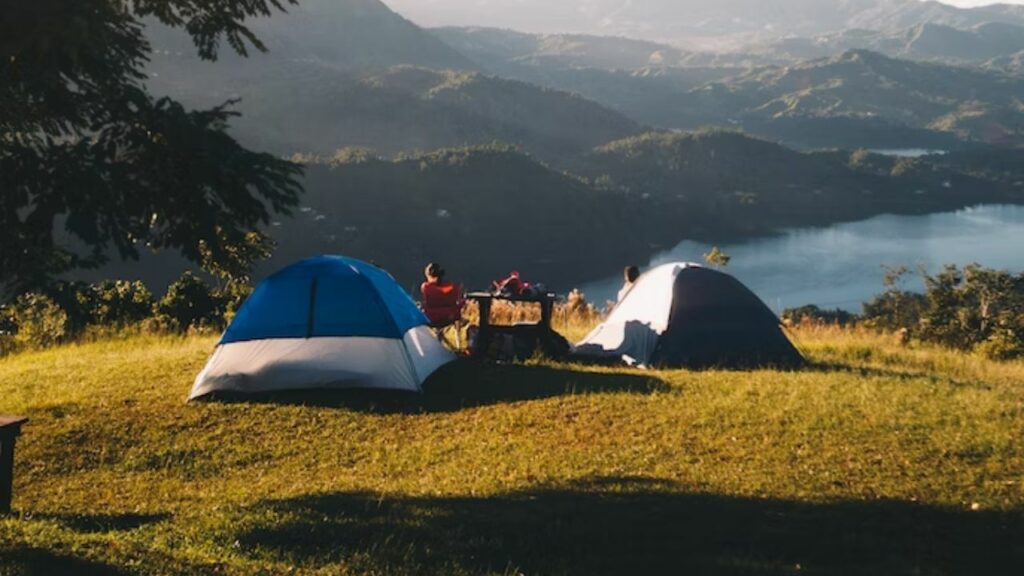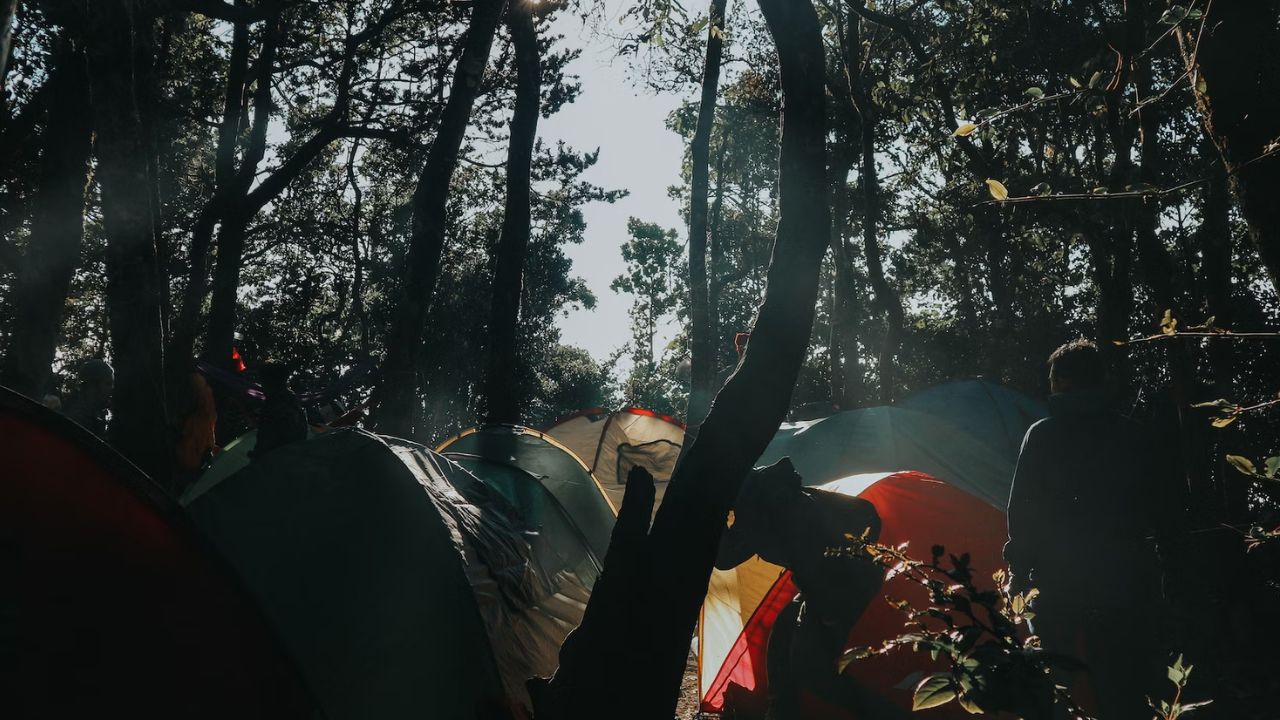Welcome to camping in the rain! It may sound uncomfortable, but it’s an exquisite experience when you know how to do it right. The air is crisp, the colors vibrant, and the atmosphere alive with mystical excitement.
Now that I have made you interested, I’ll agree that it’s harder than your usual camping experience due to the added variables. So, let’s help you step by step with your queries.
As a beginner, I had two questions: Do tents hold up in the rain? And is it okay to camp in the rain in the first place? And the answer is yes and yes.
Tents are designed to hold up in the rain and provide shelter. Modern tents are typically made from waterproof materials and feature a rainfly that helps dry the interior during rainfall. Choosing a tent with a high waterproof rating and sealed seams enhances its ability to repel water.
Additionally, proper setup, including pitching the tent on level ground and tensioning the rainfly tightly, is crucial to prevent water leaks. While extreme weather conditions may test any tent’s limits, additional measures such as using tarps or shelters can provide added protection from heavy rain.
With the right tent and proper precautions, you can trust that your tent will hold up well in the rain, ensuring a dry and comfortable camping experience.
Tip #1: Embrace the rain and the beauty of camping.
I know it sounds cheesy, but trust me, it only works if you enjoy every moment.
Rainy weather has a magical way of transforming the camping experience, creating a unique and captivating atmosphere that is truly unforgettable.
One of the unexpected advantages of camping in the rain is the scarcity of fellow campers. Many people avoid camping in wet weather, leaving you with greater solitude and privacy. It’s an opportunity to escape the crowds, reclaim a slice of wilderness just for yourself, and connect more intimately with nature.
Tip #2: Essential Gear for Rainy Camping Adventures

Equipping yourself with the right gear is essential to fully enjoy camping in the rain. Here are some key items to include in your rainy camping arsenal:
1. Waterproof tent and a rainfly.
Look for a tent with a high waterproof rating and sealed seams to keep you dry even during heavy downpours. A reliable rainfly is equally important, providing another layer of protection against rain and wind.
2. Groundsheet or tarp for added protection.
Place a groundsheet or tarp beneath your tent to create a barrier between the wet ground and your sleeping area. This extra layer of protection helps prevent moisture from seeping through the tent floor.
3. Waterproof and breathable clothing layers.
Invest in a quality rain jacket and pants to protect your upper and lower body protected from rain and wind. Opt for moisture-wicking base layers to manage perspiration and insulating layers to stay warm in cooler temperatures.
4. Reliable and waterproof jackets, pants, and boots.
A waterproof jacket with a hood, waterproof pants, and waterproof boots will keep you dry while allowing you to move freely and explore your surroundings without hesitation.
5. Waterproof bags or dry sacks for storing gear and clothing.
Use waterproof bags or dry sacks to store your gear, clothing, and other belongings that need to stay dry. These protective containers ensure your essential items remain safe and dry even if your backpack or tent gets wet.
Tip #3: Learn How to Setup Camp in the Rain
I have broken down the entire process into four easy steps.
Step 1: Choosing a suitable campsite.
Select an elevated site or a slight slope to avoid pooling water around your tent. Look for good natural drainage to prevent water from accumulating near your camping area.
Step 2: Choosing a tent site and preparation.
Before pitching your tent, clear the ground of any debris or rocks that could cause discomfort or damage. Level the ground as much as possible to prevent water from pooling inside your tent.
Time-tested Tip: Notice the direction of the rain and position your tent’s door away from the windward side to minimize water ingress.
Step 3: Secure rainfly installation.
When setting up your rainfly, ensure it is securely attached. This helps maintain proper airflow and prevents the rainfly from sagging, which can lead to leaks. Take extra care to seal the seams of your rainfly to enhance its waterproofing capabilities.
Step 4: Extend outdoor living space.
Consider setting up tarps or additional shelters to create covered outdoor spaces. These areas can serve as cooking areas, lounging spaces, or simply as a sheltered spots to enjoy the rain while staying dry.
Tarps also provide extra protection for your gear, allowing you to create designated dry zones.

Tip #4: Managing Wet Gear and Clothing
Use waterproof bags or dry sacks to compartmentalize and store your gear. Keep items organized and separate wet and dry gear to prevent moisture from spreading.
You can also hang wet clothing inside the tent or in covered areas to dry. To do so, utilize clotheslines or hooks to create drying spaces.
Tip #5: Campfire and Cooking Tips During Rainy Weather
Collect dry firewood in advance or purchase firewood from local sources. Keep it covered and protected from rain to ensure it remains dry.
Of course, you can use alternative methods such as waterproof matches, lighters, or fire starters to ignite your campfire. Once ready, prepare a covered cooking area using tarps or canopies to protect yourself and your cooking equipment from rain.
Finally, cook some deliciously warm meals. Me? I like to go with a bowl of soup or a hot chocolate for my rain adventures.
Tip #6: Activities and Entertainment in the Rain
Obviously, no one would go camping out of their homes if it was only about survival all the time. So you better prepare to have some fun even in the rain.
1. Ready your artistic skills.
Rainy weather provides a captivating backdrop for photography or sketching. Take your time to capture the falling raindrops, the dramatic cloud formations, or the ethereal mist that blankets the landscape.
2. Bring some board games and cards.
Pack a deck of cards, board games, or storytelling books to enjoy inside the tent. Rain on the tent becomes the background music for laughter, shared stories, and friendly competition.
3. Explore nearby attractions or water-related activities.
Put on your rain gear and venture out to explore nearby attractions. Visit waterfalls that come alive during rainy days, hike through misty trails, or take a leisurely stroll along a rainy beach.
Remember, the rain adds a unique ambiance to your camping experience, and with a little creativity, it can become a source of inspiration and enjoyment.

Tip #7: Safety Considerations
Camping in the rain requires additional attention to safety to ensure a secure and comfortable experience. Here are some safety considerations to keep in mind:
1. Monitoring weather forecasts: Be prepared for changing weather conditions and adjust your plans accordingly. Pack appropriate clothing and gear to handle various weather scenarios.
2. Ensuring proper insulation: Wet conditions can lead to increased heat loss from your body, making it important to prioritize insulation. Dress in layers and choose clothing made from moisture-wicking materials.
3. Have an emergency plan in place: Familiarize yourself with the signs of severe weather, such as thunderstorms or flash floods. Know the emergency procedures for your camping area and have a plan in place.
Considering these safety considerations, you can have peace of mind and fully enjoy your rainy camping adventure while prioritizing your well-being.
Frequently Asked Questions (FAQs)
1. Should you put a tarp under your tent?
It’s generally recommended to put a tarp under your tent. It provides an additional layer of protection between the tent floor and the ground, helping to prevent moisture from seeping through and keeping the tent’s interior drier.
The tarp is a barrier, shielding the tent from sharp objects, rocks, and potential ground moisture. It also helps prolong your tent’s lifespan by reducing wear and tear on the floor material. When using a tarp, ensure it’s slightly smaller than your tent’s footprint to prevent rainwater from collecting between the tarp and the tent floor.
2. Is it safe to camp in the rain?
Camping in the rain can be safe if you take the necessary precautions. Be prepared with proper gear, including a waterproof tent, rainfly, and clothing. Monitor weather conditions and be aware of any potential hazards, such as flash floods or thunderstorms.
3. How do I choose a waterproof tent for camping in the rain?
When selecting a tent, choose one with a high waterproof rating and a durable rainfly. Look for features like taped seams and a bathtub-style floor to prevent water from seeping in. Additionally, consider the size and design of the tent to ensure adequate space for your needs.
4. What should I do if my tent leaks during rain?
If you experience tent leaks during rain, use seam sealer to repair any leaks or apply the waterproofing spray to problem areas. Consider using a footprint or groundsheet beneath your tent for added protection against moisture from the ground.
5. What should I do in case of severe weather?
Monitor weather forecasts before and during your trip. If severe weather is predicted, have an emergency plan in place. Seek shelter in a sturdy structure or your vehicle if necessary. Prioritize your safety and follow any local advisories or evacuation instructions.

